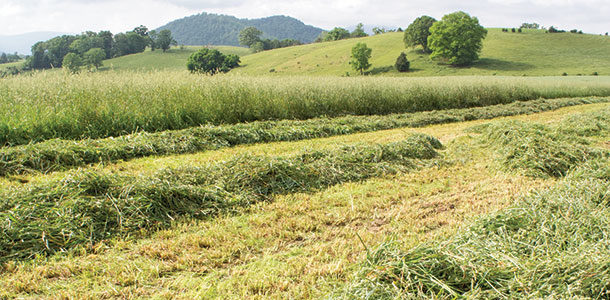For two veteran custom hay harvesters, forage quality is all about the angle of the rake and its ability to create a fluffed-up windrow.
The fluffing creates a condition in which the air can reach the hay, so it will dry faster and the hay can be baled more quickly.
Getting the hay baled a day or two sooner helps prevent yellowing, says Stan Azevedo of Azevedo Custom Hay, who has been in the business for 40 years in California’s southern San Joaquin Valley.
Azevedo says he has learned that better color can contribute to improved nutritional value of the feed, and forage with good color feeds better.
Fellow Central Valley custom harvester Mike McCurdy, of Precision Hay Co., echoes the emphasis on fluffiness. “If the rake wheel is designed to lift the crop into the air as it hits, compared to laying it back more, the hay will cure better and it will roll more tightly and curl less,” McCurdy says. “The whole point is to get it up faster so the farmer can get the water back on and get the next crop coming.”
McCurdy also focuses on the critical timing of raking and the many variables that can impact a schedule. “A lot of people don’t understand how important the time frame is in terms of raking.
Different ground conditions will affect the timing. Sandy soil dries faster, and heavy soils hold the moisture so hay will take longer to cure. Newer hay versus older hay … there is a big difference.”
McCurdy, who serves the Wasco-Bakersfield area, points out that sticking to a pre-determined schedule doesn’t work in the custom hay harvesting business.
“If you rake on schedule all year long no matter what, the farmer could lose 15 to 20 days of growing time and could lose a cutting. That’s a lot of money lost.”
How gently the rake handles the hay is as important as its ability to fluff or aerate the hay. The nutritional value of hay is linked to good harvest practices, which can help ensure the hay has the right dry matter content and will ferment properly to preserve nutrients.
Azevedo points to changes in rake design that have allowed him to work his rakes at 13 mph compared to the previous 4 to 5 mph. “I’ve been involved in testing wheel rakes for 25 years, helping manufacturers develop a gentle rake.
We have seen rakes evolve and the design improve, and the end result is that today we can efficiently provide quality forage. In today’s world, I can’t afford four rakes doing 4,000 acres a month. I need to do 400 acres a day, and I have to be efficient or I would need six to seven rakes. More equipment means more men and more maintenance – I have to be efficient to stay in business.” FG
Bruce Shannon
Sales Manager
Nikkel Iron Works










